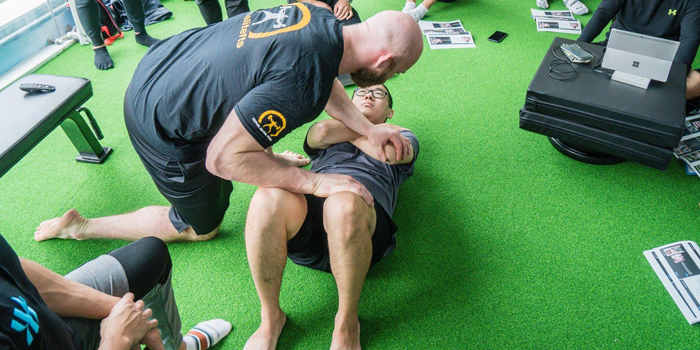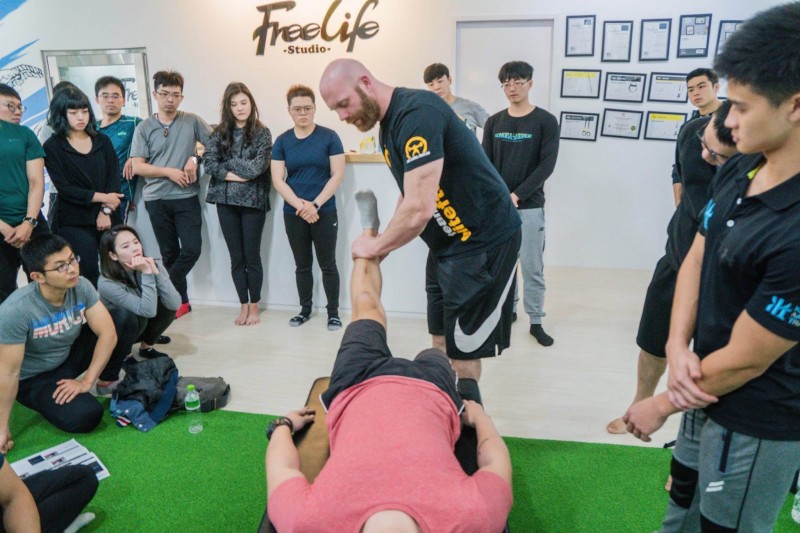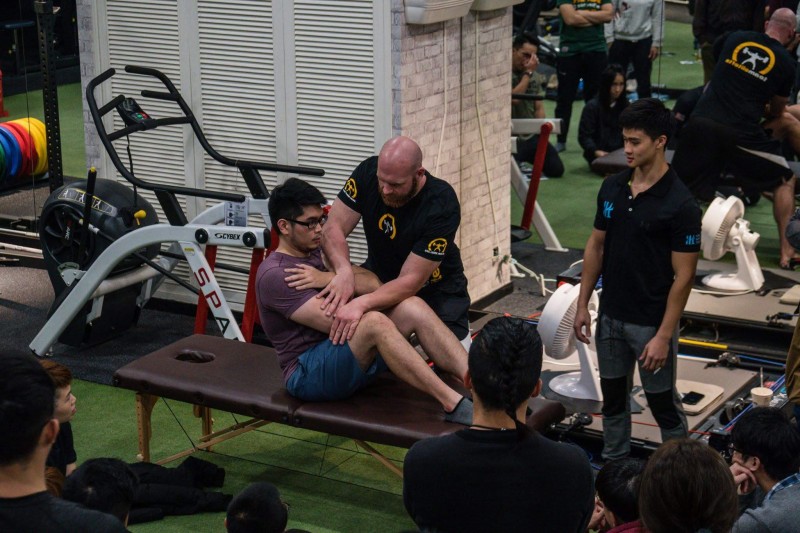
Here’s a fun joke: A lawyer, a strength coach, and a doctor walk into a bar. The strength coach orders a beer, the doctor orders a mixed drink, and the lawyer orders two fingers of scotch from the top shelf. The bartender says to the lawyer, “I am sorry, sir, but I recently hurt my arm and cannot reach the scotch from the top shelf.” Before the doctor has an opportunity to chime in, the strength coach asks a few questions and exclaims, “You probably tore your rotator cuff! You should do some external rotations, do front raises, and stay away from overhead pressing!” The lawyer turns to bartender and says, “That’s okay, pal, you just gave me the easiest lawsuit imaginable!”
I know—that probably didn’t get many laughs. But regardless of how good or bad of a joke it is, comedy often lays its roots in the realm of reality, and this joke is no exception. If you are a strength coach, personal trainer, or whatever other random fitness guru label and you’re diagnosing someone’s pain or prescribing rehab for an injury, you may want to watch your step – because you are on quite a slippery slope.
RECENT: Learning From the Mamba Mentality
Now look, I get it. People just want to help. And you probably have clients or athletes who trust your opinion and consider you to be quite an intelligent person. In fact, let’s assume that you are a highly intelligent person. You got a degree in kinesiology or exercise science; read often; have experienced and worked through your own onset of aches and pains; and have trained scores of people to get stronger, healthier, and more fit. So, what’s the harm in your trying to assist someone who is asking for help with his or her pain?

The answer is that no matter how much you think you know, how much your client trusts you, or even how shitty you may perceive the doctor across the street to be, the reality is, unless you have a piece of paper, a national board’s recognition, and a state association’s approval that says otherwise, you are not a doctor of medicine, chiropractic, physical therapy, or osteopathy. Which means that you do not have a license to give medical advice, diagnose, examine, or prescribe rehab, and you are stepping outside of your scope of practice. Should you choose to ignore this and go ahead and give advice or diagnose anyway, you’re putting yourself, your company/employer, and your client at risk for physical and legal damage. Don’t believe me? Go Google various gym and personal trainer lawsuits, and ask your liability provider if it covers your giving medical advice or negligence. I’ll give you a hint: it doesn’t. Better yet, do you even have liability insurance? Perhaps you will reconsider playing doctor.
For those who find themselves in this problem and understand their limitations but still want to be able to help, here are three tips for how to handle client injuries and pain.
1. Clearly Communicate with Your Client
I understand that you want the best for your clients. I understand that you’ve built those relationships up and that they trust your opinion. So, when a client asks you about an injury or pain that he or she is experiencing, your best bet is to maintain that trust by explaining to him or her that you are not a doctor and that he or she should seek a medical evaluation from a medical doctor, chiropractor, or physical therapist.
Now what if a client is telling you that he or she has mild/moderate (like 3/10) back pain and you’re trying to decide if you should have him or her squat today? By all means, you need to be aware of what is going on with your clients. You absolutely can and should ask questions about the pain they are experiencing. If you can find pain-free movements that don’t bother your clients, then movement is always good for the body.
2. Build a Relationship with a Local Doctor
Networking is the key to a successful business. For a strength coach or personal trainer who wants the best for his or her clients and athletes, there are tons of advantages to having a handful of local medical professionals in your network to refer to or pull from.
In my chiropractic office, I directly connect to a gym, The Spot Athletics. The Spot is a private training facility in which every customer has a coach. So, when something isn’t quite right about one of its clients, it sends the client over to me to be evaluated. This is a win-win for the client, myself, and the coach (technically a win-win-win). First, and most importantly, the client is receiving the proper attention from a health care provider to find out what the problem is. For myself, I am getting an opportunity to help my target demographic, which includes active populations and athletes who want the most from their bodies and to be healthy.
Now what about the strength coach? In all honesty, the strength coach may benefit the most in the long term from this referral. First, referring to someone who will help to solve his or her client’s problem will likely make that person even more trustworthy in the client’s eyes. Also, because I respect the trust necessary to provide a referral, I make sure that I communicate back to the coach so that he or she can be up to speed on what the client can and cannot do in the gym. This is huge for the coach for a couple of reasons. If you have documentation from a doctor of a diagnosis and what can and cannot be done in a training session, you are much more protected to be able to talk about the diagnosis and do your part to help (so long as you stay within the lines of the recommendations and restrictions).

Another reason that strength coaches often give injury advice is because they are scared that if they don’t look like they know the answer, the client will go to a doctor, they won’t see the client again for six months, and if the client does come back to the gym, the coaches will have no idea what the client has been doing during that time frame and essentially have to start all over again. Because these coaches and I have built a great relationship, I will never tell clients that their coaches “probably hurt them” or that they shouldn’t squat. And I will encourage them to continue to attend sessions while either working around or avoiding their injuries to help to keep them healthy.
3. Stay Off of Social Media
You are probably familiar with various stories about a person committing a crime and then posting something on his or her social media page either admitting to the offense or even documenting it by showing a video. And you laughed to yourself about how stupid he or she was to do that. For some reason, people have this insane desire to share every bit of their lives on social media.
I’m a millennial, and I still cannot understand how people mess this one up. If you put something on social media, it is public information. Simple as that. I don’t care if you have all of the privacy settings on and block people who aren’t your friends or followers – it’s public information. For example, it can be documented evidence of negligence, wrongdoing, guilt, or practicing without a license.
So, if you’re a coach or trainer, please don’t be a complete dumbass and give medical advice on social media. Take the advice from Tip #1 and clearly state that you are not a doctor and that this is out of your scope. Let’s say that you have had experiences with this type of injury yourself, or with other clients. State that in your experience or in the experiences you’ve had with other clients with this issue whom you referred to doctors (because you are smart and are not going to make the mistake of diagnosing and practicing without a license). Then, mention that the clients ended up having “insert conditions” and that it would be worth seeing a doctor for proper diagnoses.
If you are a strength coach or trainer, please do not take this article as a derogatory statement toward you or your profession. And don’t think that I’m singling you out. These points are not just aimed at strength coaches and trainers. They apply to manual and massage therapists, who are also not allowed within their scope to diagnose. The same concepts can be applied to diet coaches who are not registered dieticians. This article is written because I do believe that the majority of coaches want to help and probably don’t realize that their actions are putting them at risk.










